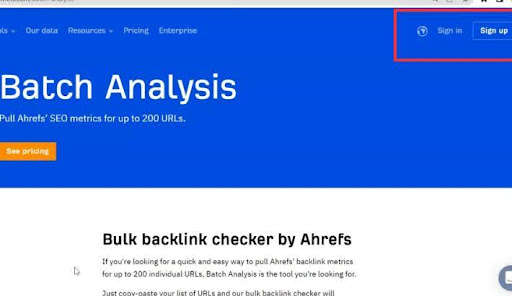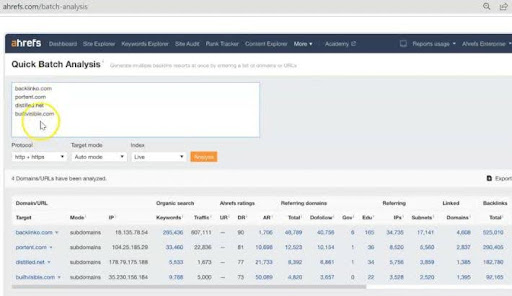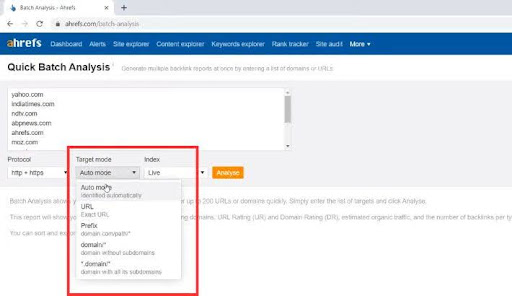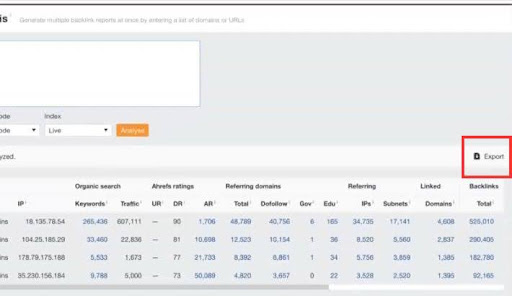
How To Use Ahrefs batch analysis?, batch analysis Ahrefs, Ahrefs bulk
If you’re looking to boost your SEO game, Ahrefs' batch analysis tool is a great way to get insights on multiple URLs at once. It lets you evaluate metrics like backlinks, organic traffic, and keyword rankings all in one go. In this guide, we'll walk you through the steps to effectively use batch analysis and make the most of your data.
Overview of Batch Analysis Ahrefs

Ahrefs batch analysis allows you to analyze numerous URLs and SEO data
Batch analysis in Ahrefs is a tool that allows users to check multiple URLs or domains simultaneously. This feature is particularly useful for SEO professionals who want to analyze the performance of various websites in one go.
Users can quickly gather important data, such as backlinks, organic traffic, and keyword rankings for each site. By streamlining the analysis process, batch analysis saves time and helps in making informed decisions for improving online visibility.
How To Use Batch Analysis Ahrefs? Step-By-Step
Learn how to use Ahrefs Batch Analysis step-by-step to analyze multiple URLs, track important SEO metrics, and easily export data for further optimization and insights.
Step 1: Access Batch Analysis Tool

Go to Ahrefs website and log in Batch Analysis tool
Go to the Ahrefs dashboard and select "Batch Analysis" under the "Tools" section. This will open the page where you can enter your URLs or keywords for analysis.
Step 2: Upload Your URLs

Upload your URLs by pasting or importing a file
You can upload up to 200 individual URLs at once by either pasting them directly into the input box or uploading a CSV file with the URLs. Ensure that every URL appears on a different line.
Step 3: Choose Metrics to Analyze

Choose the SEO metrics you want to analyze for each URL
Select the SEO metrics you want to analyze, such as backlinks, Ahrefs Rank, Domain Rating, referring domains, and social signals. You can customize your report to focus on what matters most for your analysis.
Step 4: Start Analysis

Start analysis with Ahrefs batch analysis to evaluate multiple URLs efficiently
Once you’ve uploaded the URLs and selected your metrics, click the "Start Analysis" button. Ahrefs will process the data and generate a detailed report, showing you the SEO performance of all your listed URLs.
Step 5: Review and Analyze and Interpret the Output Metrics

Analyze and interpret the output metrics in Ahrefs batch analysis to gain valuable SEO insights
After completing the analysis, you can view the report directly in your browser. The data will be presented in an easy-to-understand format with all the selected metrics for each URL, helping you identify key insights quickly.
1. Domain/URL
This column lists the domains or URLs you’ve entered for analysis. It helps you track and identify each website or page being evaluated.
By analyzing multiple domains/URLs together, you can compare their SEO performance side-by-side, ideal for competitive research.
2. Ahrefs Rank (AR)
Ahrefs Rank assigns a global ranking to websites according to the quality of their backlink profiles. A lower AR number indicates a stronger backlink profile compared to other sites in Ahrefs' database. For example, if a site has an AR of 100, it means it's one of the top 100 strongest backlink profiles globally.
3. Domain Rating (DR)
DR measures the overall strength of a domain’s backlink profile on a scale from 0 to 100. It’s based on the quality and quantity of referring domains. A higher DR typically means the domain is more authoritative and trusted, which positively impacts SEO.
4. Referring Domains
This shows how many unique domains link to your site or URL. It’s more valuable than just the total number of backlinks because one high-quality referring domain is often more powerful than multiple low-quality links. Growth in referring domains signals increased authority over time.
5. Dofollow Links
These are backlinks that transmit SEO value or "link juice" to your site. Having a strong ratio of dofollow links compared to nofollow links can positively affect your rankings, but the quality of the links matters most.
6. Traffic
Traffic represents the estimated number of organic visits the site receives from search engines. This is based on the site's current rankings and keyword performance. It helps assess the domain's visibility and effectiveness in attracting search engine users.
7. Keywords
This metric shows the number of organic keywords the domain ranks for in search engine results. A higher keyword count suggests broader visibility and reach, making it a strong indicator of a website's overall SEO success.
8. Governmental/Educational Links
Links from government (.gov) and educational (.edu) websites are shown here. These are considered highly authoritative and trustworthy, providing a significant SEO boost when obtained. They also enhance credibility and trustworthiness in search engine algorithms.
9. Backlinks
This metric displays the total number of backlinks pointing to the domain or URL. While a high number is good, the quality of those backlinks is more critical. A few high-quality links can outweigh hundreds of low-quality ones.
10. Subnets and IPs
Subnets and IP addresses show how diverse the sources of backlinks are. A large number of unique IPs and subnets indicates diversity in referring domains, which is better for SEO and reduces the risk of link manipulation.
Step 5: Export Data (Optional)

Export data from Ahrefs Batch Analysis for further SEO insights
If you want to analyze the data further or use it with other tools, you can export the report to a CSV file. Simply click the export button, and the data will be ready for download and further use.
For a step-by-step guide on using this feature of Ahrefs batch analysis, watch the video below! It provides detailed instructions to help you get the most out of this powerful tool.
Ahrefs | Introduction to Ahrefs Batch Analysis feature Step-by- Step | (Explained in English)
Ahrefs Batch Analysis is a fantastic tool for boosting your SEO performance with its powerful features. However, it can be a bit pricey. An Ahrefs Group Buy is a great alternative, which lets you access all its features at a much more affordable cost!
Evaluate Backlink Quality Using Ahrefs Batch Analysis

Evaluate backlink quality easily with Ahrefs Batch Analysis for SEO insights
Evaluate the quality of your backlinks quickly and easily with Ahrefs Batch Analysis. Let’s dive in and learn how to get the most out of it!
Check Domain Rating (DR):
High DR values indicate that the linking domain is authoritative and trusted. Focus on building backlinks from websites with higher DR scores, as they provide more SEO value.
Assess Referring Domain Relevance:
Relevance matters! Links from domains related to your niche are more valuable because they drive targeted traffic and reinforce your relevance in your industry.
Review the Linking Page Content:
Look at the context of your backlinks. Links placed within high-quality, relevant content provide much more SEO value than those embedded in random or low-quality pages.
Identify Follow vs. Nofollow Links:
While “follow” links directly pass authority to your site, “nofollow” links don’t. Don't overlook "nofollow" links, though; they can still increase website traffic and credibility.
Spot Broken Links:
Use the tool to find broken backlinks pointing to your site. Fixing these links ensures you don’t lose out on valuable SEO benefits.
Pros & Cons Batch Analysis Ahrefs
Pros | Cons |
|
|
Batch Analysis in Ahrefs is a powerful tool that lets you analyze up to 200 URLs at the same time. It generates a detailed report with key SEO metrics like Ahrefs Rank, Domain Rating, backlinks, referring domains, and social signals. You can easily view and work with the report directly in your browser, and even export the data into a CSV file for further analysis with other tools. It’s a huge time-saver for SEO tasks!
However, Batch Analysis has some drawbacks worth considering. It can only handle 200 URLs per session, which might need to be more for larger datasets. Beginners might also find navigating all the SEO metrics challenging, as there’s a bit of a learning curve. Additionally, the tool relies on Ahrefs' database updates, so it might miss newly created links. Lastly, it isn't specifically tailored for competitor analysis, which could limit its usefulness in that area.
Conclusion
In conclusion, using Ahrefs batch analysis can greatly streamline your SEO efforts by allowing you to analyze multiple URLs at once. Understanding crucial data such as backlinks and organic traffic allows you to make informed decisions to improve your approach. With just a few clicks, you’ll gain valuable insights, helping you improve your website’s performance and visibility online.


